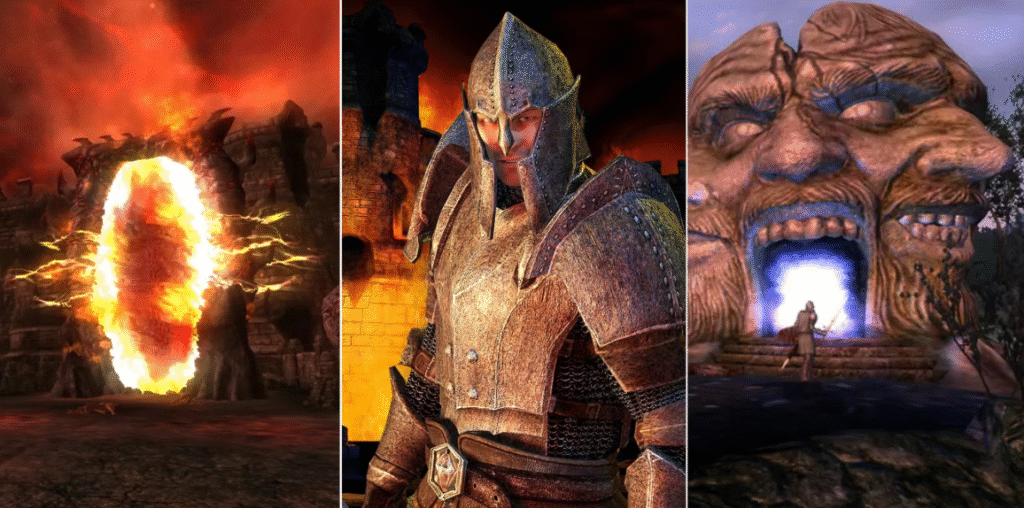Introduction
When The Elder Scrolls V: Skyrim launched in 2011, it redefined what players expected from open-world RPGs—blending exploration, deep lore, player agency, and mod support into a groundbreaking experience. More than a decade later, The Elder Scrolls VI is poised to carry that legacy forward, but under a very different spotlight. The gaming world has evolved dramatically since Skyrim’s release, with titles like The Witcher 3, Elden Ring, and Cyberpunk 2077 raising the bar for narrative design, world-building, and technical ambition.
As Bethesda slowly unveils what’s next, fans and critics alike wonder: Can Elder Scrolls VI truly innovate and redefine the genre again? Or will it simply polish an already successful formula? With promises of a new engine, next-gen systems, and larger-than-life maps, expectations are sky-high.
In this article, we explore how TES VI could not just continue the saga—but revolutionize how we think about open-world storytelling, RPG depth, and the future of interactive fantasy worlds.
The Legacy of Elder Scrolls in RPG History
When we talk about the most influential open-world RPGs of all time, The Elder Scrolls series stands at the top. From the ambitious depth of Morrowind to the immersive world of Skyrim, Bethesda’s franchise has defined—and redefined—what role-playing games can be. These titles have not only sold millions of copies globally but have also set a new standard for exploration, freedom, and modding in gaming history.
Released in 2002, The Elder Scrolls III: Morrowind introduced players to a deeply layered world filled with complex lore and open-ended gameplay. Its impact was profound, especially for PC gamers who relished the ability to shape their own narrative path. Then came Oblivion in 2006, which pushed the envelope with improved graphics, radiant AI, and voice-acted characters—ushering in a new era of immersive storytelling.
But it was The Elder Scrolls V: Skyrim (2011) that truly changed the game. With its vast open world, memorable quests, and support for thousands of fan-made mods, Skyrim became a cultural phenomenon. It remains one of the best-selling games of all time, inspiring countless developers to expand the boundaries of the RPG genre.
The Elder Scrolls legacy is more than just dragons and dungeons—it’s about player freedom, deep customization, and living, breathing worlds. The series has left a lasting mark on how modern RPGs are crafted, influencing franchises like The Witcher, Dragon Age, and Cyberpunk 2077.
As we look ahead to The Elder Scrolls VI, the question is clear: can Bethesda once again revolutionize the genre it helped shape? If history is any indication, the answer might be yes.
Innovations Fans Are Expecting
With over a decade since the release of Skyrim, anticipation for The Elder Scrolls VI is sky-high—and fans aren’t just hoping for more of the same. They’re expecting meaningful innovations that redefine the open-world RPG experience for a new generation. From advanced AI systems to deeper role-playing mechanics, here’s what fans and critics alike are hoping to see in Bethesda’s next big leap.
Smarter NPCs and Radiant AI 2.0
Skyrim’s Radiant AI was groundbreaking in 2011, but players are now looking for smarter, more dynamic non-player characters. Fans want NPCs with routines that evolve over time, react contextually to world events, and remember the player’s actions beyond scripted lines. A truly living world with unpredictable behavior would be a game-changer.
Expanded Factions and Morality Systems
Gamers are also hoping for faction dynamics that mirror real-world politics. Rather than choosing a single guild or storyline, players want multi-faction interplay—where choices impact alliances, betrayals, and the global state of the world. A more nuanced morality system that goes beyond “good vs. evil” could add significant depth.
Seamless World Design with Fewer Load Screens
One of the most-requested improvements is a fully seamless map without frequent loading screens between cities, buildings, or regions. With modern SSD technology and powerful consoles like the PS5 and Xbox Series X, this is now more achievable than ever.
Enhanced Combat Mechanics
Fans want melee and magic systems that feel fluid and weighty. Innovations like dual-wield spell crafting, reactive parrying, and more impactful stealth combat could finally bring Elder Scrolls combat up to par with modern action RPGs.
Realistic World Interactions
Interacting with the game world—be it chopping wood, farming, crafting, or building—should feel more immersive. Building on Skyrim’s Hearthfire DLC, fans hope for deeper player housing, town building, and survival elements.
Revamped Skill and Leveling System
A more flexible skill tree system that allows for hybrid classes and reactive growth could redefine how characters evolve. Fans are expecting something more adaptive than Skyrim’s relatively linear perk trees.
If Bethesda delivers even half of these expectations, The Elder Scrolls VI could usher in a new golden age for RPGs.
Open-World Evolution: Bigger Doesn’t Just Mean Better
In the world of RPGs, “bigger” has often been the marketing hook for every new release. But with The Elder Scrolls VI, fans and critics are hoping for a more refined philosophy—where size is matched by depth, detail, and interactivity.
Bethesda is known for sprawling maps, but size alone no longer impresses gamers. Modern players want meaningful content in every corner of the world—handcrafted locations, reactive environments, and stories that feel personal. A larger world must feel lived-in, not empty. The expectation is that TES VI will build on Skyrim’s open-world structure, adding complexity through ecosystems, dynamic events, and intelligent AI rather than just more landmass.
Seamlessness is another focus. With next-gen hardware, the dream of a truly continuous world—with no load screens between cities or dungeons—is closer than ever. Imagine entering a bustling market or a remote cave without transition screens, preserving immersion and realism. Games like Red Dead Redemption 2 and The Witcher 3 set a high standard for world immersion, and fans expect Bethesda to rise to that level—or surpass it.
Environmental storytelling will also play a crucial role. Instead of generic filler areas, players want every region, ruin, and road to tell a story through visual cues, found objects, and unique characters. This attention to narrative detail turns exploration into a rewarding experience.

Ultimately, The Elder Scrolls VI doesn’t just need to be larger—it needs to be smarter, richer, and more meaningful. If Bethesda balances scale with substance, it could redefine what players expect from open-world RPGs in the years ahead.
Role of Technology: How the New Engine Could Make the Difference
One of the most anticipated aspects of The Elder Scrolls VI is its foundation on Bethesda’s next-generation game engine, the Creation Engine 2. After years of criticism regarding aging graphics and clunky mechanics in previous Bethesda titles, this engine represents a major shift—and possibly the biggest leap forward for the studio in over a decade.
The Creation Engine 2 is reportedly being built from the ground up to support vast, open-world environments with modern hardware in mind, especially for the PlayStation 5, Xbox Series X, and high-end PCs. While it retains some DNA from the original engine used in Skyrim and Fallout 4, it’s expected to overhaul core systems like animation, lighting, and physics.
One of the biggest promises of the new engine is improved realism. Lighting will be more dynamic, leveraging ray tracing or similar technologies to enhance shadows, reflections, and atmosphere. Environments will feel more alive—day/night cycles, weather effects, and particle systems will all contribute to a richer sense of place.
Character animations and NPC behavior are also expected to improve significantly. Previous Elder Scrolls titles often suffered from stiff, robotic movements and limited facial expressions. With the new engine, we could see more fluid motion, nuanced emotions, and smarter AI that reacts more realistically to the player’s actions.
Another key upgrade is world streaming—a feature that could enable seamless transitions between massive areas without load screens. This would not only improve immersion but also allow Bethesda to design a truly interconnected world with minimal technical barriers.
Furthermore, modding support is expected to continue being a pillar of Bethesda’s ecosystem. Creation Engine 2 will likely offer more robust tools for modders, giving the community even more power to expand the game beyond its base version, just as they did with Skyrim.
In essence, the new engine is more than a technical upgrade—it’s a chance for Bethesda to reclaim its place at the top of the RPG genre. If implemented effectively, it could bridge the gap between ambition and execution, delivering an experience worthy of the Elder Scrolls legacy.
Lessons from Modern RPGs
As Bethesda prepares The Elder Scrolls VI, it stands in the shadow of several modern RPGs that have redefined what open-world role-playing can achieve. From The Witcher 3 to Cyberpunk 2077 (post-fixes), and Baldur’s Gate 3, the bar has been significantly raised in terms of narrative complexity, player agency, and immersive world-building.
One major lesson comes from CD Projekt Red’s The Witcher 3—a game celebrated for its meaningful side quests and character-driven storytelling. TES VI will need to move beyond fetch quests and radiant AI tasks, offering richer narratives and morally complex choices that genuinely impact the world around the player. Story depth must match the vastness of the world.
From Larian Studios’ Baldur’s Gate 3, Bethesda can learn the value of emergent gameplay and adaptive storytelling. Players now expect games to react dynamically to their decisions. If TES VI includes branching narratives, reactive NPCs, and multiple quest outcomes based on choice—not class or faction alone—it will align better with modern expectations.
Meanwhile, Cyberpunk 2077 taught the industry hard-earned lessons about launch readiness and trust. Bethesda has struggled with buggy releases in the past, and fans will no longer tolerate broken promises or incomplete systems. A smooth, polished launch—with fewer bugs and more complete features—is crucial if TES VI hopes to succeed out of the gate.
Another takeaway is from Horizon: Forbidden West and Elden Ring, which proved that exploration and environmental storytelling remain core pillars of immersion. TES VI should reward curiosity with meaningful discoveries, hidden dungeons, lore-rich items, and organic world-building.
Finally, inclusivity and customization have become standard in modern RPGs. Players want deeper character creation, non-linear progression, and inclusive storylines that reflect a broad range of identities and playstyles. Bethesda would do well to broaden their creative approach to cater to diverse global audiences.
In sum, The Elder Scrolls VI has the advantage of legacy, but it must learn from its peers to evolve. Borrowing the best elements from today’s RPG successes will ensure it’s not just nostalgic—but truly next-gen.
Community Power: Mods, Feedback & Longevity
One of the most powerful forces behind the success and longevity of The Elder Scrolls series has always been its modding community. From the sprawling fantasy overhauls in Skyrim to the immersive realism tweaks and visual enhancements in Oblivion, modders have kept the games alive long after their official support ended. For The Elder Scrolls VI, Bethesda has an opportunity—and responsibility—to fully embrace this culture.
Players expect modding tools to be robust, flexible, and easy to access, ideally available at launch. By providing an official modding kit and integrating mod support into platforms like Steam Workshop or Nexus Mods, Bethesda can unlock infinite replayability. This not only empowers creativity but helps the community fix issues and add features that might otherwise be delayed or overlooked.
Beyond mods, community feedback has shaped the evolution of Bethesda’s games for decades. With TES VI, open communication during development—through dev diaries, beta testing phases, or Q&A forums—can foster trust and deliver a game closer to fan expectations.
Moreover, mods extend far beyond aesthetics; they fix bugs, balance gameplay, and even expand lore. Some fan-created quests rival official content in quality. Bethesda would benefit by acknowledging this strength and even hiring standout modders, a strategy they’ve used successfully in the past.
In the end, The Elder Scrolls VI’s success won’t just depend on its features—but on its community-first approach, ensuring it remains relevant and replayable for many years to come.
Redefining the Genre: What Would That Look Like?
For The Elder Scrolls VI to truly redefine the open-world RPG genre, it needs to move beyond traditional expectations and offer something transformative—something that reinvents how players interact with both the game world and their own sense of agency.
First and foremost, emergent storytelling must be a core focus. While previous Elder Scrolls titles offered branching quests and lore-rich environments, future innovation lies in dynamic narratives that evolve based on not only player choices, but also on in-world variables. Imagine quests that don’t trigger from dialogue trees alone, but from how you treat NPCs, your political affiliations, your playstyle, or even your silence. A reactive world—not just a vast one—is key to redefining immersion.
Second, TES VI has the opportunity to advance AI-driven NPC behaviors. If townsfolk can remember your actions, adapt to in-game events, or form communities that change over time, the world becomes a living ecosystem instead of a static backdrop. Adding personality-driven dialogue that isn’t purely scripted could make interactions deeply meaningful and unpredictable.
Exploration and environmental interactivity also need a leap forward. Real-time climate systems, fully climbable landscapes, and unique biomes with ecosystem interdependence would make exploring feel less repetitive and more rewarding. Let players alter the world—build, destroy, influence—not just travel through it.
Another game-changing element could be cross-platform, persistent character progression, where your decisions carry over between expansions or spin-offs. Integration with cloud saves and even optional cooperative experiences—without becoming a multiplayer-focused game—could set TES VI apart.
Finally, redefining the RPG genre in 2025 means tackling representation, accessibility, and inclusivity. Giving player’s rich character customization across backgrounds, abilities, and roles—without forced archetypes—opens the game to a wider audience and deeper engagement.
Redefinition isn’t just about being bigger or prettier. It’s about crafting a role-playing experience that feels personal, alive, and limitless—true to the soul of the Elder Scrolls universe but bold enough to shape the genre’s next chapter.
Cautious Optimism: Managing Hype and Expectations
As excitement continues to build around The Elder Scrolls VI, it’s crucial for fans and the gaming community to approach the upcoming title with a balanced mindset—one of cautious optimism. After all, Bethesda’s legacy is rich with groundbreaking open-world experiences, but it’s also been marked by missteps and overpromising, as seen with titles like Fallout 76 and the rocky launch of Starfield.
Anticipation is natural, especially given the decade-long wait since Skyrim, but it’s important to remember that game development has grown more complex, especially with the shift to next-gen expectations. Massive scope, photorealistic environments, and AI-driven worlds take time—and often come with technical hurdles at launch.
Bethesda has promised that TES VI will be a “decade-defining” game, but fans should temper expectations with the understanding that no game can fulfill every wish. The best approach? Appreciate what the developers deliver, while giving room for growth through patches, expansions, and community support.
Managing hype doesn’t mean lowering standards—it means setting realistic expectations. Focus on verifiable details, official announcements, and proven gameplay features instead of unconfirmed leaks or wishful thinking.
In short, TES VI is poised to be a monumental release, but staying grounded will ensure that excitement doesn’t turn into disappointment—and allows players to fully enjoy the game for what it is, not just what it could’ve been.
Conclusion: A New Era Awaits
The Elder Scrolls VI represents more than just the next chapter in a beloved franchise—it symbolizes a pivotal moment in the evolution of open-world RPGs. With expectations running high, Bethesda has the opportunity to redefine what immersive, dynamic storytelling can look like in modern gaming. From new technologies and ambitious world-building to the passionate involvement of the modding community, TES VI has all the ingredients to become a genre-defining experience.
Yet, as fans eagerly await its release, managing expectations remains key. The lessons learned from recent RPG launches—both triumphs and failures—highlight the importance of patience and open-mindedness. If executed well, The Elder Scrolls VI could not only meet the high bar set by Skyrim, but surpass it. For now, one thing is certain: the journey through Tamriel’s next frontier is shaping up to be one of the most anticipated adventures in gaming history.



